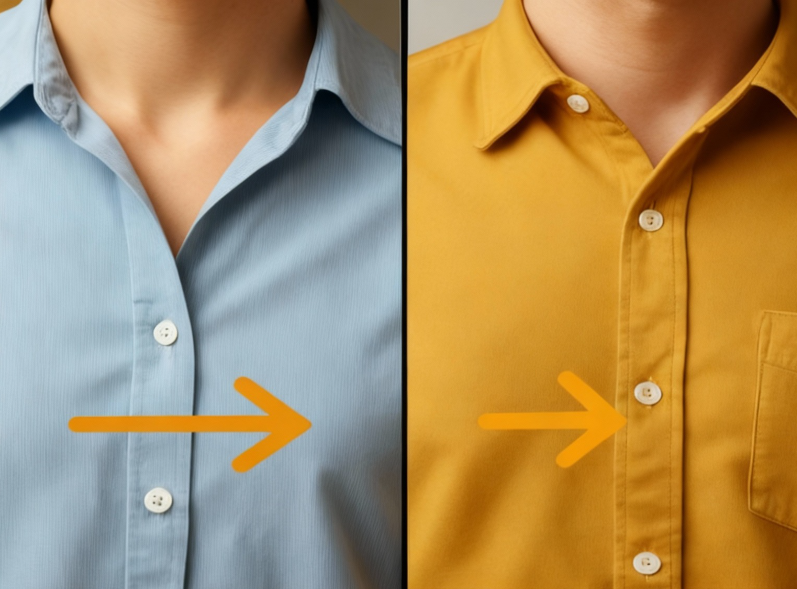Most of us get dressed each morning without ever considering the tiny details built into our clothes. One such detail is so familiar that it almost disappears into the background: women’s shirts button left over right, while men’s shirts button right over left. It seems ordinary, yet this small distinction has a long history, reflecting the routines, expectations, and social structures of the past.
This design difference didn’t happen by chance. It grew from practical considerations of how clothing was worn, who dressed whom, and what daily life demanded. For women, particularly those in the upper classes of the 18th and 19th centuries, dressing was often a complex affair. Wealthy women wore multiple layers: corsets tightened at the back, bodices with hooks or buttons, petticoats, heavy skirts, and gowns fastened in several places. These outfits weren’t designed for independence—they assumed the help of someone else, usually a maid.
Because most people are right-handed, dressmakers placed buttons on the left side of women’s garments so that maids could fasten them more easily. From the maid’s perspective, it made the process quicker and smoother—a small adjustment that mattered in a world where dressing was a collaborative task. Even as women’s fashion eventually became simpler and more practical, left-side buttoning endured. It became a subtle mark of refinement, outlasting the original practical reason for its placement.
Men’s clothing followed a different path. Historically, men’s garments were designed for practicality, especially when carrying weapons was common. For centuries, men typically wore swords or knives on their left side, so they could draw them with their dominant hand. Buttons on the right allowed the garment to open from left to right, keeping it out of the way during movement and ensuring the fabric stayed tight on the side nearest the weapon.
This detail became associated with military uniforms, discipline, and practicality. Over time, right-side buttoning became more than functional—it became a sign of structure and order. Even after swords disappeared from daily life, the convention remained, embedded in the silhouette expected for men’s fashion.
Today, those centuries-old choices still live in closets worldwide. Most people never think about why their shirts button the way they do, but that is exactly what makes the detail fascinating: a small piece of hardware carries echoes of a society long gone.
Women no longer rely on maids to dress them. Men no longer need to keep a sword clear. Yet the buttons remain where history placed them. Clothing manufacturers could have reversed the system decades ago, but fashion traditions are stubborn. Practical solutions became aesthetic choices, and aesthetic choices became the standard.
There’s something almost poetic about it: a buttonhole, as small as it is, holds centuries of human habits, social class, and cultural norms. Each time we button a shirt without thinking, we participate in a ritual shaped by lives long before ours.
It also reveals how slow fashion is to let go of the past. Even in an age of zippers, stretch fabrics, and digital design, button placement persists. Designers continue these conventions because people expect them. A women’s blouse buttoning left feels “right,” a men’s shirt buttoning right feels “natural.” The original logic has long faded, yet the instinct remains.
Zooming out, this tiny detail reveals a larger truth: clothing is never just fabric. It carries stories about how people lived, what they valued, and how society structured itself. It preserves the past, even as the world moves forward. A simple button becomes a quiet historical record, stitched into daily life.
So next time you fasten your shirt without thinking, remember: you’re touching a piece of history. A design shaped by maids helping ladies get ready for a ball, by soldiers adjusting coats before battle, by centuries of social expectation.
Even if those old practices are no longer necessary, fashion still carries them—not because they serve a practical purpose, but because they have become part of the language of clothing itself. In that way, buttoning a shirt links the present to a past whose influence quietly shapes our everyday moments.
